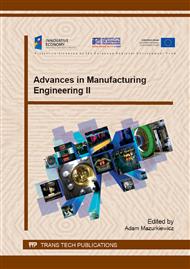p.3
p.9
p.15
p.21
p.27
p.34
p.41
p.47
Universal Research Instrumentation for Erosion Tests
Abstract:
The research on erosion resistance can be classified into two groups, i.e. standardized research, conducted with specific parameters of the test and dedicated to commercially available products, and experimental studies whose the aim is to investigate different mechanisms of erosion (e.g. micro-cutting, the formation of grooves, fatigue wear, and cracking and chipping of brittle materials) with different parameters of the process, i.e. the angle of impact of the particles, the speed and particle size, the particle temperature, and the temperature of the eroded material. Devices available on the market allow the implementation of erosion tests in accordance with the requirements of the standards. Experimental studies are carried out exclusively on laboratory equipment with incomparable characteristics. The Institute for Sustainable Technologies - National Research Institute in Radom designed and produced a universal testing device enabling investigations both in accordance with the requirements of the applicable standards: ASTM-G76, PN-76/C-81516, PN-EN ISO 16282, as well as experimental research. The device enables the execution of experiments in a wide range of parameters relevant to the processes of erosion, i.e. temperature (≤ 600 °C), the angle of the sample relative to the abrasive particles (25o to 90o), the speed of abrasive particles (10 to 130 m/s) and abrasive particles flow (2 to 10 g / min). In the paper, the authors described the construction of the device and the reported ranges of the erosive wear test parameters and presented examples of the results of tests for selected solid materials and selected coatings produced by PVD methods.
Info:
Periodical:
Pages:
21-26
Citation:
Online since:
August 2015
Authors:
Keywords:
Price:
Сopyright:
© 2015 Trans Tech Publications Ltd. All Rights Reserved
Share:
Citation:


